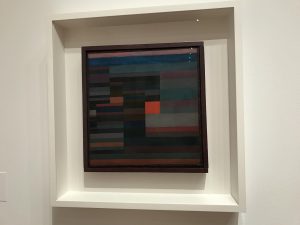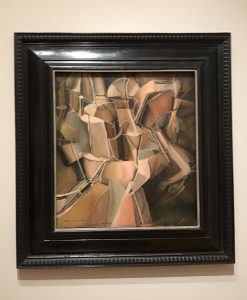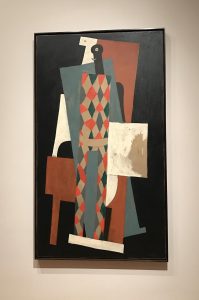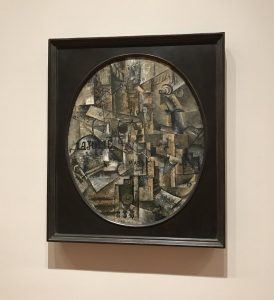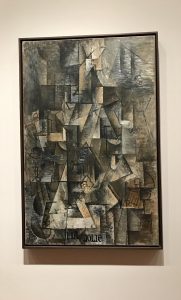In terms of methodology, I went to Moma for site visit in order to find out the history and theory of Cubism and its intersection with design practice. In Moma, there were the original pieces of artwork during Cubism, such as Georges Braque’s Man with a Guitar, Pablo Picasso’s Musicians with Masks, and Broadway Boogie Woogie’s Piet Mondrian. There were also sculptures of Picasso, Guitrars. By looking at some actual artworks from Cubist’s artists, I could feel the atmosphere and the overall style of Cubism. It was a different experience to see the artwork around me from looking at their work online. From Moma, I could find qualitative data by observing the artwork with my subjective point of view. For the quantitative data, I will find out the statistics of time period for designers who took Cubism as their inspiration and how Cubism could blend into the designer’s style during the time. Furthermore, I will go to Metropolitan Museum to see if there are some objects or fashion which are inspired by the characteristics of Cubism.
Advanced Research Seminar
ARS_WEEK 8
strategy and timeline for research method
1.Site visit – MOMA
Cubism artwork or related artworks focused on the use of geometric shape
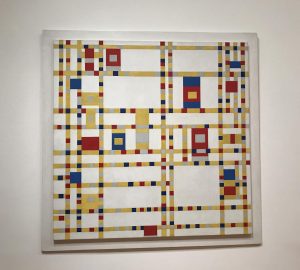 Broadway Boogie Woogie – Piet Mondrian
Broadway Boogie Woogie – Piet Mondrian
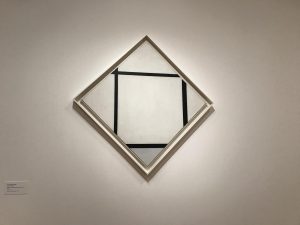
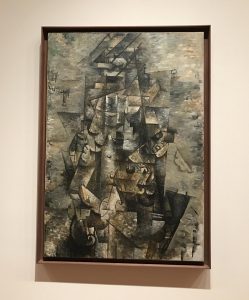 Man with a Guitar – Georges Braque
Man with a Guitar – Georges Braque
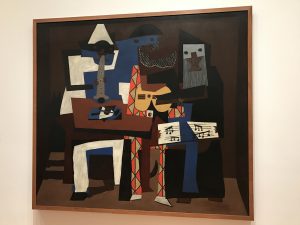 Musicians with Masks – Pablo Picasso
Musicians with Masks – Pablo Picasso
2. object analysis – Cubists’ paintings in MOMA
3. visual analysis
ARS_Image Archive
• “Image Archive” add 10 images that relate to your research for your latest Learning Portfolio post, citing the images in Chicago Style, and describing in 20-50 words how the image supports your research.
Tagliavini, Christian. Dame di Cartone, Cubism I. Photograph. Christian Tagliavini. c2008. From Christian Tagliavini portfolio. Cardboard. http://www.christiantagliavini.com/portfolio/portfolio.php?idcat=1
Christian Tagliavini is a photographer who blends fine arts and craftsmanship. The above image is a great example of mixing cubism and craftsmanship. Christian designs stories based on unexplored themes and unusual concepts, so this example shows how cubism can be blended into design practice.
Margiela, Maison. Investigation of Volume and Texture. Photograph. New York: Vogue, c2009. Vogue Runway. Collection of Spring 2010 Ready-To-Wear. Fashion, http://www.vogue.com/fashion-shows/spring-2010-ready-to-wear/maison-martin-margiela
This avant-garde look shows how cubism has continued to influence modern fashion and designers. By attaching shirt asymmetrically on the another shirt, this look breaks the stereotype of symmetrical and perfectly sewn shirt.
Garcons, Comme des. Investigation of Volume and Texture. Photograph. New York: Vogue, c2009. Vogue Runway. Collection of Spring 2010 Ready-To-Wear. Fashion, http://www.vogue.com/fashion-shows/spring-2010-ready-to-wear/maison-martin-margiela
This deconstructive look from Comme des Garcons breaks the standard pattern that the sleeves are attached on the front and the pants are sewn on the skirt asymmetrically. In Cubist artwork, objects are analyzed, broken up and reassembled in an abstracted form. Instead of depicting objects from a single viewpoint, the artist depicts the subject from a multitude of viewpoints to represent the subject. This look can be a metaphor of Cubist artwork since it represents multitude of viewpoints and the coexistence of time by attaching the sleeves on the front.
Garcons, Comme des. The Infinity of Tailoring. Photograph. Paris: Vogue, c2013. Vogue Runway. Collection of Fall 2013 Ready-To-Wear. Fashion, http://www.vogue.com/fashion-shows/fall-2013-ready-to-wear/comme-des-garcons
This outfit expresses the coexistence of time, which is one of the characteristics of cubism. The unworn jacket is attached on the jacket inside and it arouses the illusion of four arms. The deconstruction of tailoring jacket breaks the stereotype of traditional tailoring technique.
Montoya, Rocio. Between Skin and Blue. Photography. Madrid: Montoya, c2015. Art Campaign for “Abstraction,” Life with Bird. Collage. http://rociomontoya.com/portfolio_page/lifewithbirdxrocio/
The use of collage represents cubism. Some parts are deconstructed and taken apart, show the characteristics of cubism.
Thecuadro, Pablo. Mixed Media Collage. Madrid: Thecuadro, c2016. Collage. http://trendland.com/pablo-thecuadro-mixed-media-collage/
His philosophy of using collage relates to the idea of cubism. One of the characteristics of cubism is to use the collage. Pablo Thecuadro finds inspiration in searching for a new conception of fashion. According to Pablo, the complexity of the collage goes beyond cutting. It is based on an abstraction, starting with basis of realities, it generates a new and generally disruptive concept.
Picasso, Pablo. Portrait of Dora Maar. Paris, c1937. Oil on Canvas, https://www.wikiart.org/en/pablo-picasso/portrait-of-dora-maar-1937-1.
This portrait by Pablo Picasso is from Cubism period, providing several viewpoints of a single object. This makes it more difficult for the viewer to ‘see’ the entire image in a single glimpse. The color and the use of shape are related to my topic.
Delaunay, Sonia. Sonia Delaunay Fashion Illustration. New York, c1919-1923. Source: Plates from Portfolio “Sonia Delaunay; ses peintures, ses objets, ses tissus simultanés, ses modes,” Special Collections and FIT Archives. Marker, https://pinsndls.com/2011/03/10/color-moves-art-and-fashion-by-sonia-delaunay/
Sonia Delaunay is an abstract cubist who applies her theories to all areas of visual expression, including graphics, interiors, fashion and textiles. This fashion illustration focuses on shape and color. The way she draws is unconventional and abstract, which is related to my topic.
Huntington, Jeff. Patch. Painting. c2011. Oil. http://jeffhuntington.com/artwork/1980674_Patch.html
This portrait by Jeff Huntington provides multiple viewpoints of a person’s face, which represents cubism. This makes viewers to see the image in several perspectives.
Yaman, Elif. Fashion and Cubic Forms. c2011. Source: UCREATIVE. Digital Art, http://www.ucreative.com/inspiration/30-impressive-samples-of-cubism-in-graphic-design/
This artwork shows how cubism influenced modern digital art. Cubism is the concept of objects being broken up, analyzed, and re-assembled into abstract forms. This art portrays a multitude of viewpoints to represent subjects in a greater context.
Week3_ARS
<Checklist of historical sources and theoretical sources>
1. Lehmann, Ulrich. “Art and Fashion.” In The Berg Companion to Fashion, edited by Valerie Steele. Oxford: Bloomsbury Academic, 2010. Accessed February 13, 2017. https://www-bloomsburyfashioncentral-com.libproxy.newschool.edu/products/berg-fashion-library/encyclopedia/the-berg-companion-to-fashion/art-and-fashion.
This source is helpful in a way that it explains “the breaking up of corporeality (cubism) was inspired by and became visually reflected in contemporary couture.” It helps me to understand the relationship between cubism and fashion.
2. McNeil, Peter. “Art and Dress.” In Berg Encyclopedia of World Dress and Fashion: West Europe, edited by Lise Skov, 522–527. Oxford: Berg, 2010. Accessed February 13, 2017. http://dx.doi.org.libproxy.newschool.edu/10.2752/BEWDF/EDch8087.
In this article, “Richard Martin has argued in Cubism and Fashion (1999) that a visual revolution occurred in both art and fashion between 1908 and 1930, in which the belle epoque focus on the three-dimensional carapace of nineteenth-century fashion dissolved into a focus on either flatness or modular cylindricality.”
3. Stabb, Jo Ann. “Influence of the Arts.” In Berg Encyclopedia of World Dress and Fashion: The United States and Canada, edited by Phyllis G. Tortora, 255–266. Oxford: Bloomsbury Academic, 2010. Accessed February 13, 2017. http://dx.doi.org.libproxy.newschool.edu/10.2752/BEWDF/EDch3035.
Jo explains that “the international style advocated utter simplicity and elimination of ornamentation—“form follows function.” In its quest for universal geometric purity, it also played cubistic solids against voids, giving each equivalency. This reductionist philosophy stripped away nonessentials and provided cold, clean abstract shapes and uncluttered surfaces that eventually led to minimalism.”
4. Martin, Richard. 1999. Cubism and fashion. New York: Metropolitan Museum of Art. https://www.worldcat.org/title/cubism-and-fashion/oclc/796022322/viewport
